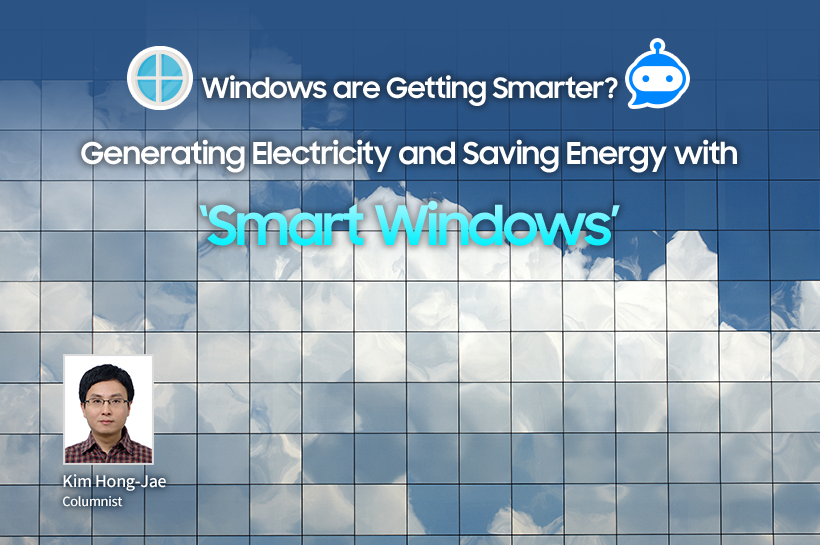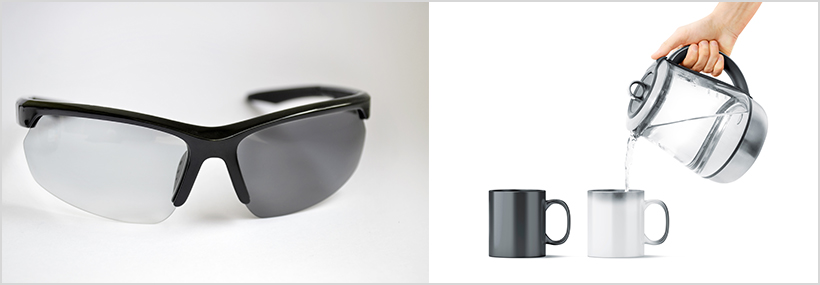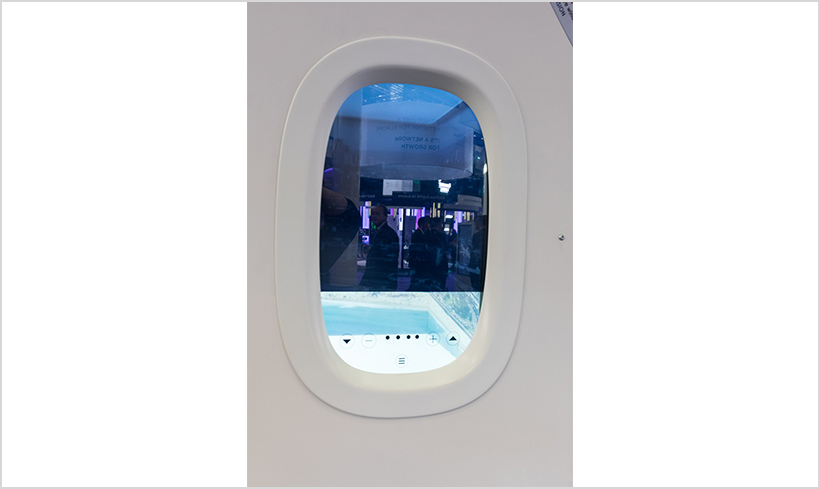
Are you dreaming of a glass palace in a fairy tale? Since some time ago, the area occupied by windows has gradually increased in buildings, and even buildings with all outer walls covered with windows are appearing. Modern glass buildings, ranging from public buildings to office buildings and residential and commercial apartments, are gaining popularity.
If the exterior wall of the building is decorated with glass windows, an unobstructed view can be secured from the inside, and the sunlight is reflected and flashed from the outside. However, the biggest problem is that the air conditioning is weak, and if you turn on the air conditioner on a hot summer day like these days, you will be shocked by the electricity bill.
A smart window that overcomes the problems of glass windows is emerging. A smart window is a glass window that can freely control how much sunlight from outside enters the room. It reduces energy loss and reduces heating that can improve efficiency and provide a comfortable indoor environment.
A Passive Smart Window that Adjusts the Indoor Temperature Accordingly to the External Environment
The method of controlling how much sunlight passes through the smart window can be divided into passive and active types. The passive smart window is a method in which the glass window changes itself according to the surrounding environmental conditions. To put it simply, you can understand that there is no need to turn on the power when the smart window is working. The passive smart window has the advantage of being suitable for energy saving because it controls the light transmittance by itself according to the external environment. Methods such as photochromic, thermochromic, and thermotropic are common examples.
Photochromic is a method in which the transmittance is adjusted according to the intensity of sunlight, and thermochromic is a method in which the transmittance is adjusted according to changes in external temperature. As the intensity of sunlight and external temperature change, oxidation - reduction reactions occur in the materials filled in the smart window, resulting in a change in the color of the window. When the color of the window becomes dark, the sunlight does not penetrate well into the inside of the building, and when the color of the window becomes transparent, the sunlight flows into the building.

On the other hand, thermotropic is a method in which a filled material undergoes a phase transition from a liquid to a solid by heat to control the transmittance. It mainly uses a hydrophilic polymer that binds well to water, but when it reaches a certain temperature, the property changes to hydrophobic, which does not want to be mixed with water, and solid grains are formed to scatter light and lower transmittance.
Personalized Active Smart Windows Based on Individual Preference
An active smart window is a method of controlling the color or light transmittance of a window through an electrical signal. To put it simply, you can understand that smart windows have devices for power supply and operation. At first glance, it may seem that it is inferior to the passive type, but it is a great strength that people can freely adjust them to their liking at any time they want. Techniques such as electrochromic, polarized particle devices, and polymer dispersed liquid crystals are being used.
Electrochromic is produced by filling a material whose color changes due to an electrochemical reaction between transparent electrodes. In general, tungsten oxide (WO3) is widely used as an electrochromic material, and it has a memory characteristic that it consumes and maintains power only during switching, so it has the advantage of low power consumption. However, it is a pity that it takes a long time for discoloration if the product area is large.

A polarized particle device (Suspended Particle Device, SPD) is manufactured by inserting a film layer containing polarized particles between transparent substrates coated with a conductive material. Normally, the polarized particles are randomly scattered and block light. However, when a voltage is applied, the polarized particles align side by side in the direction of the electric field, and light is transmitted through them. The response speed is fast, the effect is excellent, and it can be used in a wide temperature range, but the drawback is that it is expensive.
Polymer Dispersed Liquid Crystal (PDLC) is made by putting a polymer matrix film layer between transparent substrates coated with a conductive material. Small spherical liquid crystal materials are dispersed in the polymer matrix film. Like the polarized particle device, the liquid crystals are arranged in a disorderly manner in normal times and light is scattered. When a voltage is applied, the liquid crystals are aligned and light can pass through.
As active smart window technology advances, the method of controlling the color and light transmittance of glass windows is also evolving. Recently, the preferred smart window adjustment method among people is to use a smartphone app. In particular, SPD (Suspended Particle Device) and PDLC (Polymer Dispersed Liquid Crystal) are gaining popularity because the glass window can be quickly adjusted from transparent to opaque to various levels according to the user's taste through smartphone commands.
Smart Windows That Can Even Produce Solar Energy
Despite the many advantages of active smart windows, the fact that they require power to operate is a clear limitation. SPD and PDLC consume considerable power when operating because they remain transparent only when voltage is applied. It is ironic that a smart window is called a smart window and must continuously spend energy to keep it transparent like a normal window.
Scientists have found a reasonable solution to a thorny problem. It combines an active smart window that requires continuous power and a solar power generation system that generates electricity itself. To install a solar panel in a building, a large area is required where it can receive good sunlight. However, installing Building-Integrated PhotoVoltaic (BIPV) in the building can solve all the thorny problems.
In the case of BIPV applied to windows, above all, it is possible to design and construct in consideration of the aesthetic elements of a building only when it maintains light transmission and visibility, which are the original functions of glass windows. To this end, a crystalline silicon solar cell should be manufactured in the form of a thin film. Such an inorganic thin film solar cell can be applied to various substrates, can be lightweight, and has excellent durability and stability, but its efficiency is lower than that of a crystalline silicon solar cell.
The Korea Institute of Materials Science announced this year that it has developed an organic material-based smart window film that uses solar cells to control the brightness of light itself for the first time in Korea. Existing smart window technology is manufactured based on inorganic materials and requires high-temperature processing or has problems in terms of flexibility. The research team solved this problem by manufacturing high-performance solar cells and electrochromic devices based on organic materials.
The research team produced a high-efficiency organic solar cell by introducing organic molecules between the electron transport layer and the photoactive layer that receives light and generates current in the solar cell. Thanks to the organic molecules between the electron transport layer and the photoactive layer, flexibility was improved in terms of interfacial bonding, and good performance was obtained even in large-area devices. The developed smart film can be applied not only to existing buildings but also to bent places, so it is expected to be commercialized for various purposes such as automobiles in the future.
'Smarter' Windows Using Sensors
By using the sensor developed by the joint research team of POSTECH* and KAIST** last year, the color of the window can be changed according to the ambient humidity. It can be used to develop smart windows that allow more sunlight to pass through when the outside humidity is high, such as during the rainy season. Changing the color of windows to darken on low-humidity days and brightly on high-humidity days can reduce gloom during the long rainy season.
*POSTECH (Pohang University of Science And Technology) is a private South Korean university dedicated to engineering and the sciences.
**KAIST (Korean Advanced Institute of Science & Technology) is South Korea’s first research-oriented science and engineering institution.
With the development of Internet of Things (IoT) and Information & Communication Technology (ICT), smart windows are expected to become smarter as their name suggests. By using various sensors, it is possible to accurately grasp various situations happening inside and outside the window in real-time and then take appropriate action. Advanced smart windows are more convenient because they take care of themselves without needing human attention.
To provide the most comfortable living environment, the smart window collects various information through sensors that measure temperature, humidity, and illuminance, and adjusts the indoor temperature and brightness to the optimal state. If the rain sensor is used, the window can be closed by itself in case of sudden rain to prevent rainwater from entering the house.
Today, air pollution is emerging as one of the environmental crises in the world. If the fine dust sensor is used, it is possible to create a smart window that continuously measures indoor air quality and automatically ventilates when the air quality deteriorates.




